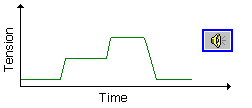(9.6) Harmonic Movement
In the previous topic, we created a harmonic backing for a melody using the related chords of the melody's scale. You may have wondered how we decided to arrange them in a progression, since there are so many combinations we could have chosen.
In general, you will be relying heavily on your ear to decide which chords work well with the melody, and what order they should be arranged in. This is (of course!) as it shoud be. Music is a human art, not a mathematical problem.
As you listen to harmonic movement, it may help to imagine a 'shape' to the music, feeling the tension varying with each chord change, up to the satisfing release (or resolving) of tension with the last chord.

There are many common harmonic movements from one related chord to another that occur often in music. We will look at several of these, within the Major scale, to give you a few ready-made ideas and a sense of what the possibilities are.
We will express all of these movements in roman numeral notation to help you transpose them to any key, but an example for each will also be given in the key of C.
An important harmonic relationship exists between the I and V chords in any key, particularly with the V7, which resolves very strongly to the Imaj.

Here's another example progression with the I and V chords. It will probably sound quite familiar, as appears at the end of many a ram-bam-da-da-da symphony.

The next most important chord after the I and V is the IV. These three chords can be arranged in pretty much any order and still create a solid harmonic movement. Some examples are shown below.



There are many songs which contain only these three chords. Too many, in fact. So bear this in mind and try to add extra interest (with other chords) to your own compositions.
Another strong harmonic movement is from a major chord to the minor chord three semitones below it. If you remember, this is the same interval which separates a Major scale and its related Minor scale.
It most often occurs between the I and the VIm chord. These two, together with the VI and V chords, create the well-used progression known as a 'turnaround'.

The same type of harmonic movement can also occur from the IV chord to the IIm, as shown below. The movement in the latter half of this example (IIm-V-I) also occurs frequently in other situations.

Songs using the Major scale in a relative minor mode will usually favour the minor related chords. Notice how the example below parallels with the I-IV-V progression from above - each is a minor chord three semitones below its equivalent major.

A nice balance to aim for is a combination of minor and major chords, such as with these examples.


|
Topic 113 of 117
| ||
Bring these music concepts to life with the free Songtrix Bronze Edition as you create songs from chords and scales.
Then publish and share your ideas with the other musicians you meet on the ChordWizard Network.
Have questions? Join the ChordWizard Network and post them in the Music Theory forum for answers and discussions on your topics of interest.








